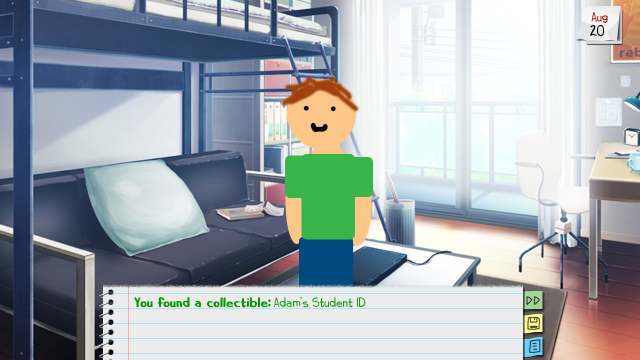Another thing I wanted to include in my game was little items that were both fun to collect, and also gave some indication of how much of the game you’d explored.

So the game has collectibles: Small named items that you acquire throughout the game that you can view descriptions of in a dedicated section of the menu. This isn’t a novel idea, by any means, but it also wasn’t entirely straightforward to set up. (Probably because I was really new to RenPy at the time.)
First, the core code that makes it work. There’s two sections here: First is the declaration of the actual items you can pick up, to keep it in one place, along with the associated persistent storage code:
init python:
if persistent.collection is None:
persistent.collection = set()
def merge_collections(old, new, current):
current.update(old)
current.update(new)
return current
renpy.register_persistent('collection', merge_collections)
python early:
collectitems = {
"adamid": ("Adam's Student ID", "A student ID for one Adam James Prewitt. It looks well-worn."),
"jalapeno": ("Jalapeno", "A whole jalapeno from dinner with Adam."),
…other items here…
}
Second, because I wanted to be able to easily grant these items as part of the game script, there’s a custom command that grants items. Again, note the Lint check, which is super useful to catch typos and missed sections when you rename items:
python early:
def parse_collect(lex):
what = lex.rest()
return what
def lint_collect(what):
if not what in collectitems:
renpy.error("Invalid collectible " + what)
def execute_collect(what):
if what in persistent.collection:
return
formatmsg = "{color=#090}{b}You found a collectible:{/b} "
if what in collectitems:
formatmsg += collectitems[what][0]
else:
renpy.error("Invalid collectable " + what)
persistent.collection.add(what)
if len(persistent.collection) == 1:
formatmsg += "\n(Access your collection from the main menu or pause menu. Collectible items will persist between games.)"
formatmsg += "{/color}"
renpy.say("", formatmsg)
renpy.register_statement("collect", parse=parse_collect, execute=execute_collect, lint=lint_collect)
This can then be straightforwardly called as part of your game script. The best part is that you don’t have to put it behind a conditional, because the player will only be notified if they don’t already have the item.
adam "Anyway…"
"He smiles at you before quickly walking out the door."
collect adamid
hide adam
So that grants collectibles, and tells the player when they receive a new one, but how to show the collection to the player? You have to make a new screen, which is thankfully straightforward. First, the screen that actually shows item descriptions, pulling from the map of valid collectible items you defined earlier:
screen itemdesc(itemid):
tag itemd
modal True
image "sp/itembg.png" at Position(xpos=0.5, ypos=0.5, xanchor=0.5, yanchor=0.5)
vbox at Position(xpos=0.5, ypos=0.5, xanchor=0.5, yanchor=0.5, xmaximum=1280, ymaximum=250):
text collectitems[itemid][1] id "collectitemtext" xalign 0.5 yalign 0.5 xmaximum 570 ymaximum 200
null height 10
textbutton "Dismiss" action Hide("itemdesc") xalign 0.5 yalign 0.5
Then the screen that lists the collectibles and makes them clickable to show their descriptions:
screen mycollection():
tag menu
use game_menu(_("Collection"), scroll="viewport"):
vbox:
spacing 10
text "Found " + str(len(persistent.collection)) + "/" + str(len(collectitems)) + " collectibles" id "collectiblescount"
for k in sorted(persistent.collection):
if k in collectitems:
textbutton collectitems[k][0] action Show("itemdesc", itemid=k)
Finally, add your screen as an item in the standard menu:
textbutton _("Load") action ShowMenu("load")
textbutton _("My Collection") action ShowMenu("mycollection")
Note that this doesn’t feed into the achievements system, but you probably don’t want it to… hundreds of achievements for every little thing in your game is probably overkill. But doing it this way allows the ability to easily add new collectibles (just add a new row to your map, and then collect itemname in your script) that persist between different plays of your game.
